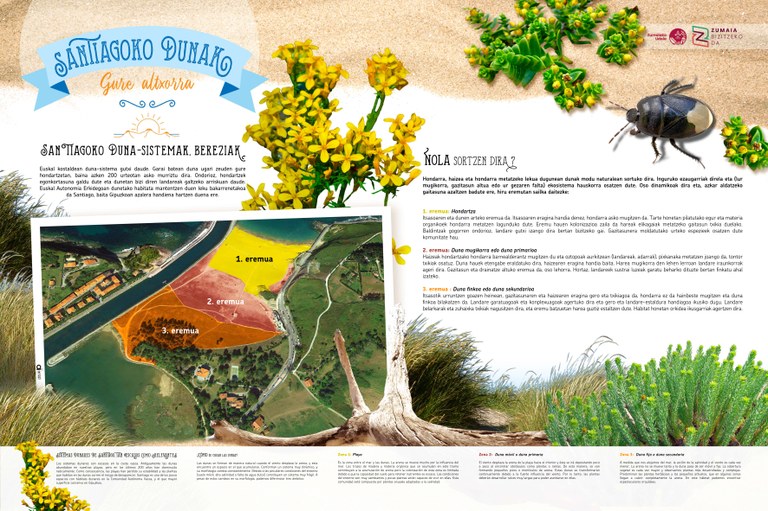1. How are dunes formed?

THE SANTIAGO DUNES, AS SCARCE AS THEY ARE IMPORTANT
Dune systems are very scarce along the Basque coastline. In the past, dunes were commonplace on our beaches, but over the last 200 years their presence has declined sharply. Consequently, our beaches have become increasingly unstable and the plants that grow in dune habitats are in danger of disappearing from our region. Santiago is one of the few places in the Autonomous Community of the Basque Country to still have dune habitats, and is the largest area of its kind in the province of Gipuzkoa.
HOW ARE DUNES CREATED?
Dunes are formed naturally when wind causes sand to move and accumulate in a specific area. They constitute highly dynamic systems with an ever-changing morphology. Due to the unique conditions of their environment (mobile ground, high salinity and lack of fresh water), dune systems are very fragile. Despite their ever-changing morphology, most dune systems can be divided into three distinct zones:
Zone 1 - Beach:
The zone located between the sea and the dunes. The sand moves a lot due to the influence of the sea. The pieces of driftwood and organic matter that are washed up in this zone contribute to the accumulation of sand, although its colonisation is limited due to the fact that the ground is unable to retain many nutrients. The environmental conditions are constantly changing and few plants are capable of surviving here. This community mainly comprises annual plants well-adapted to saline conditions.
Zone 2 - Mobile or primary dunes:
The wind blows the sand inland from the beach and deposits it little by little as it encounters obstacles such as plants or branches. As the sand is deposited, it forms small peaks or mounds. These dunes are constantly changing due to the strong influence of the wind. Plants therefore have to develop very long roots in order to thrive.
Zone 3 -Fixed or secondary dunes:
As we move away from the sea, the influence of the saline environment and the wind grows weaker. The sand does not move around so much and the dune shifts from being mobile to being fixed. Plant cover increases and more developed and complex plants take root. Most are herbaceous plants and small bushes, which in some areas completely cover the sand. This habitat is often home to spectacular orchids.

 turismoa@zumaia.eus
turismoa@zumaia.eus
 Bulegoa
Bulegoa








